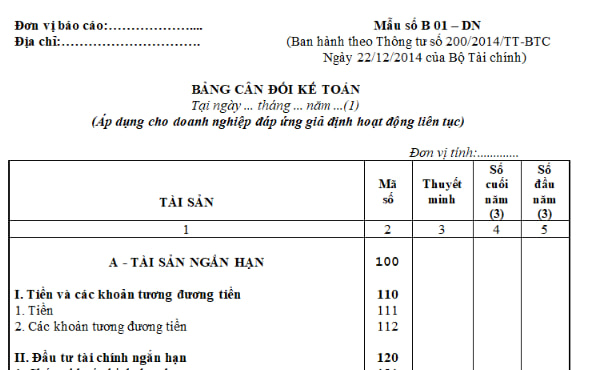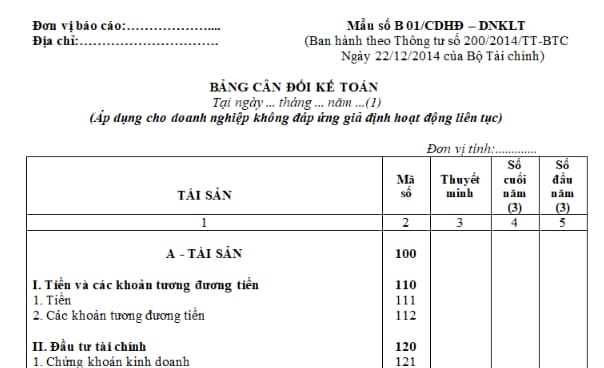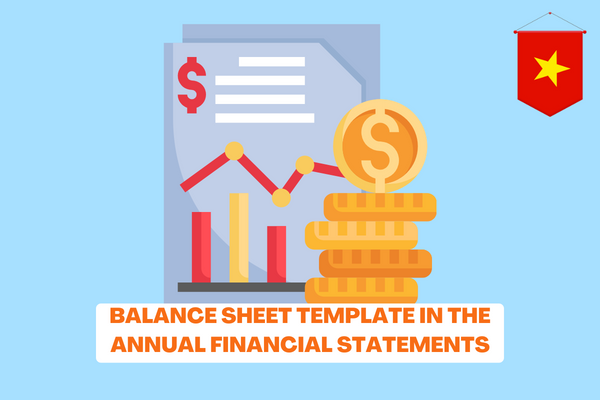Vietnam: What is the balance sheet form in the annual financial statements? What is the principle of drawing up the balance sheet of the enterprise?
- What is the balance sheet form in the annual financial statements in Vietnam?
- Is it mandatory for enterprises that meet the assumption of continuous operation of making a balance sheet to ensure what principles must be ensured in Vietnam?
- What regulations should the balance sheet ensure in the businesses that do not meet the assumption of continuous operation programming in Vietnam?
What is the balance sheet form in the annual financial statements in Vietnam?
- The balance sheet form in the annual financial statements of the enterprise meets the assumption of continuous operation: Form B 01 – Enterprise issued together with Circular 200/2014/TT-BTC, specifically as follows:

Download The balance sheet form in the annual financial statements of the enterprise meets the assumption of continuous operation: here
- The balance sheet form in the annual financial statements of the enterprise does not meet the assumption of continuous operation: Form B 01/CDHD – DNKLT issued together with Circular 200/2014/TT-BTC, specifically as follows:

Download The balance sheet form in the annual financial statements of the enterprise does not meet the assumption of continuous operation: here

Vietnam: What is the balance sheet form in the annual financial statements? What is the principle of drawing up the balance sheet of the enterprise?
Is it mandatory for enterprises that meet the assumption of continuous operation of making a balance sheet to ensure what principles must be ensured in Vietnam?
Pursuant to Point 1.2 Clause 1 Article 112 of Circular 200/2014/ND-CP Enterprises that meet the assumption of continuous operation of making balance sheets must ensure the following principles:
(1) According to the provisions of accounting standards "Presentation of financial statements" when preparing and presenting balance sheets, they must comply with the general principles of preparing and presenting financial statements. In addition, on the balance sheet, the items of Assets and Liabilities must be presented separately into short-term and long-term, depending on the term of the normal business cycle of the enterprise, specifically as follows:
+ For enterprises with normal business cycles within 12 months, assets and liabilities are classified into short-term and long-term according to the following principle:
++ Assets and Liabilities are recovered or paid within the next 12 months from the time the report is classified as short-term;
++ Assets and Liabilities are recovered or paid for 12 months or more from the time the report is classified as long-term.
+ For enterprises with normal business cycles longer than 12 months, assets and liabilities are classified into short-term and long-term according to the following conditions:
++ Assets and Liabilities recovered or paid within a normal business cycle are classified as short-term;
++ Assets and Liabilities that are recovered or paid for a period longer than a normal business cycle are classified as long-term.
In this case, the enterprise must clearly explain the characteristics of determining the normal business cycle, the average time of the normal business cycle, the evidence of the production and business cycle of the enterprise as well as the industry or field of operation of the enterprise.
+ For businesses that, due to the nature of their activities, cannot rely on the business cycle to distinguish between short-term and long-term, assets and liabilities are presented according to diminishing liquidity.
(2) When drawing up a Consolidated Balance Sheet between superior units and subordinate units that do not have legal status, the superior unit must exclude all balances of items arising from internal transactions, such as accounts receivable, payable, internal loans.... between superior units and subordinate units, between subordinate units.
The technique of excluding internal items when compiling a Report between a superior unit and a subordinate accounting subordinate is carried out similarly to the technique of consolidating a Financial Statement.
(3) Indicators without exempt figures presented on the Balance Sheet. The enterprise actively re-evaluates the ordinal number of indicators according to the principle of continuity in each section.
What regulations should the balance sheet ensure in the businesses that do not meet the assumption of continuous operation programming in Vietnam?
Pursuant to Clause 2, Article 112 of Decree 200/2014/ND-CP stipulating that the balance sheet of an enterprise does not meet the assumption of continuous operation
(1) The presentation of the balance sheet indicators when the enterprise does not meet the assumption of continuous operation is made similar to the balance sheet of the enterprise while in operation except for some of the following adjustments:
- Irrespective of short-term and long-term: The targets are not based on the remaining period from the date of preparation of the report is more than 12 months or not more than 12 months or more of a regular business cycle or in a normal business cycle;
- Failure to present contingency indicators because all assets and liabilities have been reassessed at net realizable value, recoverable value or fair value;
(2) Some indicators have different methods from the balance sheet of the enterprise that is operating continuously as follows:
- "Trading securities" (Code 121)
This indicator reflects the book value of business securities after revaluation. Enterprises do not have to present the indicator "Provision for discounts on business securities" because the number of discount provisions is recorded directly in the book value of business securities.
- Indicators related to investments in subsidiaries, joint ventures, associates, capital contribution to other units reflected in the book value after revaluation of the above investments. Enterprises do not have to present the indicator "Long-term financial investment provision" because the number of provisions is recorded directly in the book value of investments.
- Indicators related to receivables reflected in book value after revaluation of receivables. Enterprises do not have to present the "Difficult receivables provision" indicator because the amount of provision is recorded directly into the book value of receivables.
- Target "Inventories" Code 140:
This indicator reflects the book value of the inventory after revaluation. This indicator data includes unfinished production and business expenses and equipment, supplies and spare parts classified as long-term on the balance sheet of the enterprise that is operating continuously. Enterprises do not have to present the indicator "Inventory discount provision" because the discount provision is recorded directly in the book value of the inventory.
- Indicators related to tangible assets, intangible assets, financial leased assets, investment real estate reflected according to the book value after revaluation of the above assets. Enterprises do not have to present the "Cost of Value" indicator because the book value is a revaluation value, do not present the "Accumulated wear and tear" indicator because the depreciation amount has been recorded directly into the book value of the asset.
(3) Other indicators are presented by combining the content and data of the corresponding indicators in the long-term and short-term parts of the enterprise that is operating continuously.
LawNet
